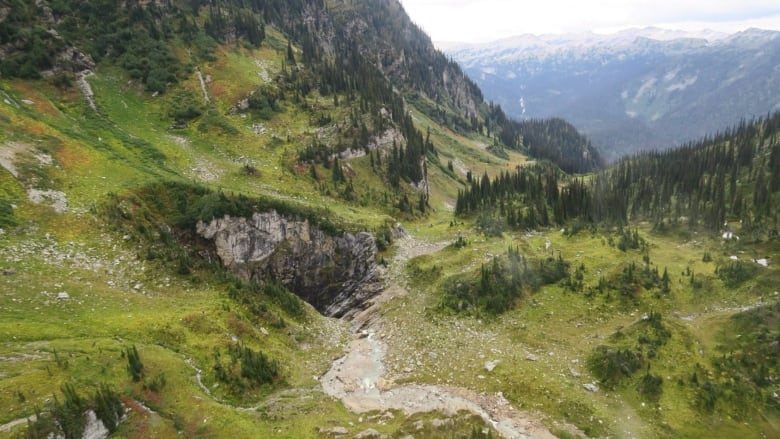What’s Inside This Enormous Canadian Cave?
It’s deep, wide, and named after a “Star Wars” character.

In the spring of 2018, a team of researchers soared above the rugged, northeastern portion of British Columbia’s Wells Gray Provincial Park in a helicopter. Below them, the ground was a patchwork of green, brown, and white—clusters of trees, expanses of rock, and swaths of snow. They were looking for caribou, but they found something else.
At first, they weren’t exactly sure what. It was definitely a divot in the earth, but from a distance, it was hard to tell whether it was a hole stuffed with ice and snow, or a crater—some dent from a long-ago volcanic eruption.
Whatever it was, the team dubbed it “Sarlacc Pit,” in homage to the Star Wars creature who hunkered down in the ground of Tatooine. To learn more about this earthly feature, they needed eyes on the ground—and beneath it.
The researchers recruited Catherine Hickson, a volcanologist well-versed in the park’s geology. After studying photographs and satellite images of the feature, a group consisting of Hickson, a caver, a parks official, and the helicopter pilot who spotted the cave from the air got up close in September, the Canadian Press reported this week. When Hickson and her team arrived, their attempts to take precise measurements were stymied by a thick mist rising up from swift-moving waters.
“We just stood there in awe of this immense, gaping hole,” Hickson says. “All we could see was a black void.” It was essentially a vertical drop.
But, farther from the edge, they also found a spring on the side of the valley. “One of the ways we trace caves is by finding springs that suddenly appear out of nowhere,” Hickson says. The team proposed that the deep, dark hole was a cave, and that the spring was one of its possible outlets.

Based on their preliminary assessment, the researchers believe the cave may be among Canada’s largest. The cave’s wide mouth spans some 328 feet. In the soupy mist, they could only measure 442 feet down, but the spring is 1.2 miles away and 1,640 feet below the opening. “We’re guessing that’s the minimum total length and depth, but it could be much deeper than that, and there could be alternative pathways,” Hickson adds.
That’s still far shallower than the country’s deepest cave, Bisaro Anima, which plunges more than 2,100 feet down. To measure Bisaro Anima, a team had to descend into the water-filled channel, or sump, wearing scuba gear. Rappelling into Sarlacc’s depths will also require a lot of equipment, and there is only a narrow window of the year when it’s possible to get down there—most months, snow and ice could block the way, or quick-moving water could be dangerous or hard to pass through.
Hickson and company hope to send another envoy in 2020—and when they do, the cave will likely shed its extraterrestrial name. British Columbia parks officials will consult with local First Nations groups to inquire about existing names for the cave, according to Canadian Geographic, which first reported the story in November—but there don’t appear to be any in journals, and the team that made the recent journey wouldn’t be surprised to learn that the steep, slippery interior hadn’t seen much foot traffic in the past. Located in a valley with several glaciers, the cave is far from the tourist circuit, and likely too remote to appeal even to hikers or hunters, Hickson says.
Researchers probably flew above it for years, Hickson adds—but probably didn’t notice it because the caribou counts are usually conducted earlier in the winter, when there’s a thicker blanket of snow. The cave may have gone overlooked on days with sharp shadows, too, when its opening could have seemed like a trick of the light.
The team will know more when they finally reach the bottom. And whatever they find there, it will be something very much of this world.




















Follow us on Twitter to get the latest on the world's hidden wonders.
Like us on Facebook to get the latest on the world's hidden wonders.
Follow us on Twitter Like us on Facebook